
A raft of data has been released recently illustrating the sharp drop-off in housing transactions since mid-2010.
First, the total number of home sales across Australia in 2012 was the lowest since 1996, according to RP Data (see next chart).
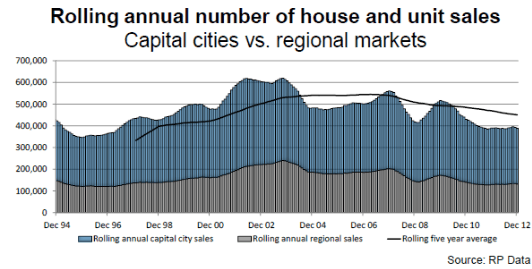
Second, the average holding period for Australian houses has risen substantially over the past decade, from 6.8 years ten years ago to 9.3 years currently, according to RP Data (see next chart).
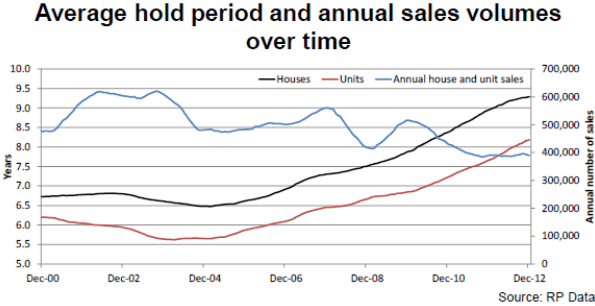
And finally, the dwelling turnover rate, as measured by the RBA, has fallen to levels not seen since the early-1990s recession (see next chart).
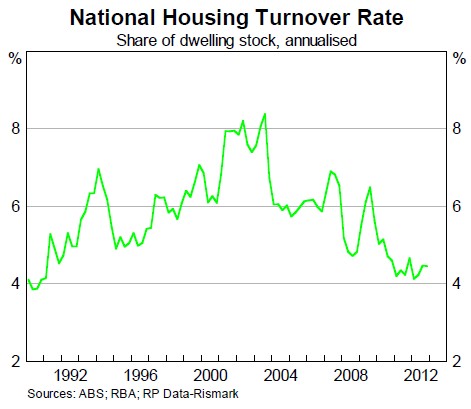
The sharp fall in housing transactions has reaped havoc on state government finances, which tend to be highly reliant on conveyancing duties (‘stamp duties’). In 2011-12, total receipts from property stamp duties were -20% below the peak levels of 2007-08, in spite of the solid gain in property values over that time period (see next chart).
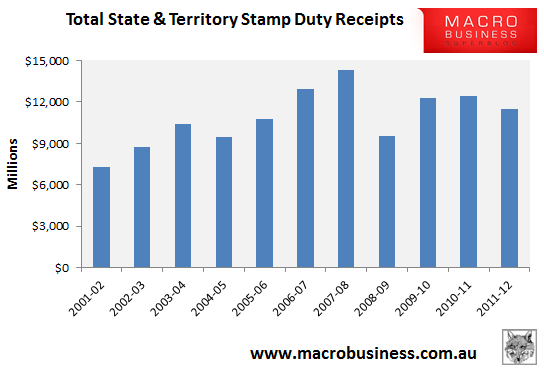
Last year, the ACT Government announced the bold (and sensible) plan to transition out of stamp duty over 20 years, replacing it with a broad-based land tax levied via an increase in property rates. Reforming stamp duty was also a recommendation of the Henry Tax Review, which characterised stamp duty as an inefficient tax, and recommended replacing it with broad-based land taxes levied on all properties, which are more efficient. And in their recent pre-budget submission to the Australian Treasury, the Urban Development Institute of Australia (UDIA) called for an end to stamp duty over a five-year phase out period.
Removing stamp duties has a lot of merit. It is a highly inefficient tax that discourages housing turnover by unneccesarily penalising people that move to homes that better suit their needs. Obvious examples include baby boomers downsizing from large family homes and young growing families upsizing to bigger family-friendly homes. Such disincentives inevitably lead to an inefficient use of the housing stock, such as empty nesters occupying large homes with multiple spare bedrooms. Stamp duties also hinder labour mobility since they discourage workers from relocating closer to employment.
Stamp duties are also highly inequitable. As shown in the above RBA chart, just over 4% of the housing stock is currently transacted annually. As such, we have a bizarre situation where only around 4% of the population are paying taxes that support services for the whole community – all for the privilege of moving to a home that better suits their needs!
As shown in the below chart, stamp duties can chew-up tens-of-thousands of dollars when purchasing a median priced home. Seeing as we all consume government services, wouldn’t it then be fairer and more efficient to levy each household a much smaller amount, rather than penalising only the small minority?
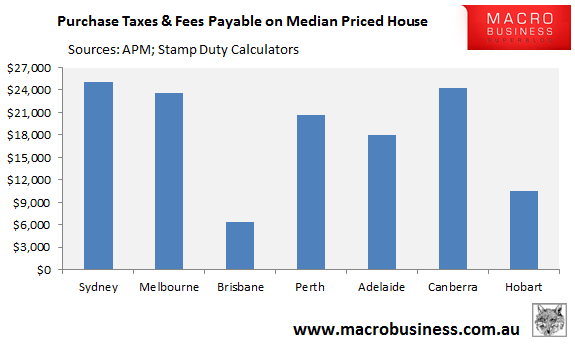
Of course, any abolishion of stamp duty would need to ensure that those that recently purchased a property (and paid the tax) are not double-taxed. Accordingly, a gradual phase-in like the ACT model would be fairest and most workable.
So what are policy makers waiting for?

